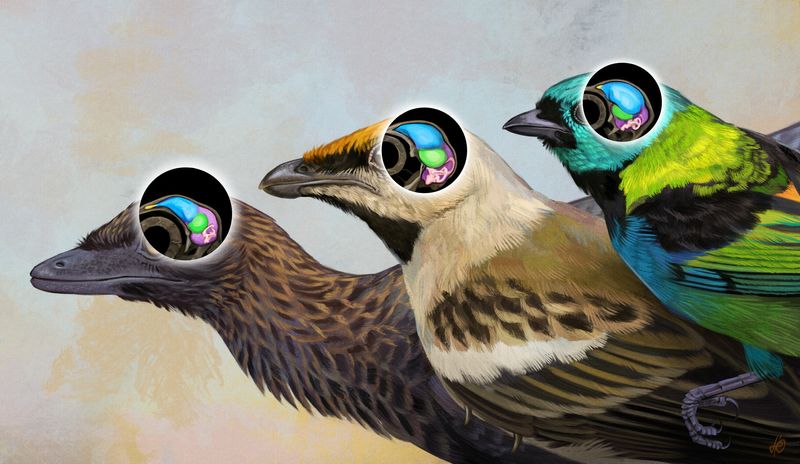By Will Dunham
(Reuters) - The brains of today's birds facilitate a level of cognitive prowess and behavioral complexity rivaled only by mammals. But how the avian brain evolved over many millions of years from an ancestral dinosaurian form has long puzzled scientists. That has now changed thanks to a spectacular fossil discovery in Brazil.
Researchers unearthed the skull of a previously unknown starling-sized bird species named Navaornis hestiae that was so well preserved they were able to digitally reconstruct its brain and inner ear anatomy based on the shape of the braincase. It inhabited an arid environment about 80 million years ago during the Cretaceous Period, the last chapter in the age of dinosaurs.
"This finding is one-of-a-kind," said University of Cambridge paleontologist Guillermo Navalón, co-lead author of the study published on Wednesday in the journal Nature.
Birds evolved from small feathered dinosaurs during the Jurassic Period. The Navaornis discovery filled in a gap of 70 million years in the understanding of the evolution of avian neuroanatomy, dating back to the earliest-known bird Archaeopteryx, which lived in Europe some 150 million years ago.
The Navaornis skull, with a modern geometry in terms of the shape of the bill and large eye sockets, looks superficially like that of a small pigeon. Its brain displayed a mosaic of modern and archaic features, and some that are in between.
"It is long-sought evidence because well-preserved 3D skulls of early birds - those that flew over the heads of dinosaurs - are extremely rare, and this one is the best preserved ever," said Natural History Museum of Los Angeles County paleontologist and study co-lead author Luis Chiappe.
"Scientists have struggled to understand how and when the unique brains and remarkable intelligence of birds evolved. The field has been awaiting the discovery of a fossil exactly like this one," said University of Cambridge paleontologist and study senior author Daniel Field.
The Navaornis brain - measuring about four-tenths of an inch (10 mm) across - was smaller, relative to skull size, than in modern birds, but larger and more complex than in Archaeopteryx.
Its cerebellum, a brain structure that in living birds helps coordinate motor control during flight, was smaller than in today's avian species and more like Archaeopteryx's. But its brain was connected to the spinal cord in a fashion similar to modern birds - and, for that matter, people - and unlike in Archaeopteryx and the dinosaurs from which birds evolved.
It bore some traits intermediate between Archaeopteryx and modern birds. The intermediate size and shape of its cerebrum, a structure that in extant birds contains the areas involved in complex cognition, suggests it was more advanced cognitively than the earliest birds but less so than today's birds.
'UNEXPECTED SPECIALIZATIONS'
Navaornis exhibits some unique characteristics like a vestibular apparatus, the organ of balance in the inner ear, larger than in any other known bird.
"There was a significant gap (in the fossil record) between birds like Archaeopteryx that had a more dinosaur-like type of brain and those that are very closely related to modern birds. The new evidence documents an intermediate phase in the evolution of the brain but with some unexpected specializations that may have been related to functional traits such as flight," Chiappe said.
There is a dearth of well-preserved fossils from the early stages of avian evolution. The fragility of bird bones makes their fossils uncommon. This skull was three-dimensionally preserved, rather than crushed flat like many fossils. The fossil, which included 80% of the bird's skeleton, indicated it was a competent flier.
Its name means "Nava's bird," named for William Nava, the scientist who discovered the fossil in 2016 in Sao Paulo state in southeastern Brazil.
Navaornis belonged to an avian group called enantiornithines that flourished during the Cretaceous but was wiped out in the asteroid strike 66 million years ago that doomed the dinosaurs but spared the avian lineage still thriving today. That means Navaornis was not ancestral to today's birds, and its modern-looking traits evolved separately from theirs.

Its beak was slender and delicate, suggesting a diet of insects and seeds it could swallow whole. It lived alongside huge long-necked plant-eating dinosaurs and large meat-eating dinosaurs.
"At first glance, it would probably have looked a lot like a living bird. However, a closer examination probably would have revealed a number of archaic features absent in living birds, such as claws protruding from the wings," Field said.